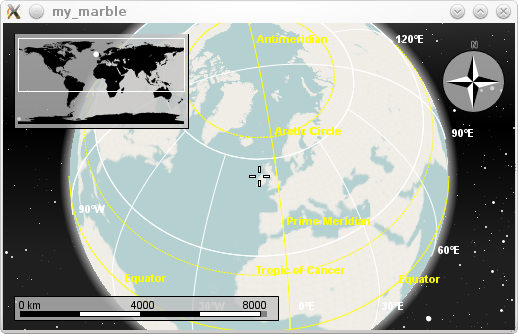Marble/MarbleCPlusPlus: Difference between revisions
No edit summary |
m Ochurlaud moved page Projects/Marble/MarbleCPlusPlus to Marble/MarbleCPlusPlus |
||
| (16 intermediate revisions by 6 users not shown) | |||
| Line 1: | Line 1: | ||
{{TutorialBrowser| | {{TutorialBrowser| | ||
| Line 13: | Line 13: | ||
== Hello Marble! == | == Hello Marble! == | ||
The Marble | The API of the Marble library allows for a very easy integration of a '''map widget''' into your application. | ||
Let's prove that with a tiny '''Hello world'''-like example: Qt beginners might want to have a look at the [http://doc.trolltech.com/widgets-tutorial.html Qt Widgets Tutorial] to learn more about the details of the code. But this is probably not necessary. For a start we just create a [http://doc.trolltech.com/qapplication.html QApplication] object and a [http://api.kde.org/4.x-api/kdeedu-apidocs/marble/html/classMarble_1_1MarbleWidget.html MarbleWidget] object which serves as a window. | |||
By default the MarbleWidget uses the ''Atlas'' map theme. However for our first example we choose to display streets. So we set the maptheme id to | |||
[http://www.openstreetmap.org OpenStreetMap]. Then we call [http://doc.trolltech.com/qwidget.html#show QWidget::show()] to show the map widget and we call [http://doc.trolltech.com/qapplication.html#exec QApplication::exec()] to start the application's event loop. That's all! | |||
<source lang="cpp-qt"> | |||
#include <QtGui/QApplication> | #include <QtGui/QApplication> | ||
#include <marble/MarbleWidget.h> | #include <marble/MarbleWidget.h> | ||
| Line 38: | Line 39: | ||
return app.exec(); | return app.exec(); | ||
} | } | ||
</source> | |||
</ | Copy and paste the code above into a text editor. Then save it as <tt>my_marble.cpp</tt> and compile it by entering the following command on the command line: | ||
<source lang="bash"> | |||
g++ -I /usr/include/qt4/ -I /usr/include/qt4/QtGui -I /usr/include/qt4/QtCore -o my_marble my_marble.cpp -lmarblewidget -lQtGui -lQtCore | |||
</source> | |||
< | If things go fine, execute <tt>./my_marble</tt> and you end up with a fully usable OpenStreetMap application: | ||
</ | |||
[[Image:My_hello.png]] | |||
The latest source code of this example can be found [https://quickgit.kde.org/?p=marble.git&a=blob&f=examples%2Fcpp%2Fhello-marble%2Fmain.cpp here]. | |||
{{tip| | |||
Here's a little checklist to tackle some problems that might arise when compiling the code above: | Here's a little checklist to tackle some problems that might arise when compiling the code above: | ||
* You need Qt and Marble development packages (or comparable | * You need Qt and '''Marble development packages''' (or comparable git installations) | ||
* If Qt headers are not installed in /usr/include/qt4 on your system, change the path in the g++ call above accordingly. | * If ''Qt headers'' are not installed in '''/usr/include/qt4''' on your system, change the path in the g++ call above accordingly. | ||
* Likewise, add -I /path/to/marble/headers if they're not to be found in /usr/include | * Likewise, '''add -I /path/to/marble/headers''' if they're not to be found in /usr/include | ||
}} | |||
{{note| | |||
If you provide maps in your application please check the '''Terms of Use''' of the map material. The map material that is shipped with Marble is licensed ''in the spirit of Free Software''. This usually means at least that the authors should be credited and that the license is mentioned. | |||
E.g. for ''OpenStreetMap'' the license is [http://creativecommons.org/license/by-sa/2.0 CC-BY-SA]. Other map data shipped with Marble is either public domain or licensed in the spirit of the BSD license. | |||
}} | |||
Latest revision as of 21:01, 10 March 2016
| Tutorial Series | Marble C++ Tutorial |
| Previous | C++, Qt |
| What's Next | Tutorial 2 - MarbleWidget: Changing basic map properties |
| Further Reading | n/a |
Hello Marble!
The API of the Marble library allows for a very easy integration of a map widget into your application.
Let's prove that with a tiny Hello world-like example: Qt beginners might want to have a look at the Qt Widgets Tutorial to learn more about the details of the code. But this is probably not necessary. For a start we just create a QApplication object and a MarbleWidget object which serves as a window. By default the MarbleWidget uses the Atlas map theme. However for our first example we choose to display streets. So we set the maptheme id to OpenStreetMap. Then we call QWidget::show() to show the map widget and we call QApplication::exec() to start the application's event loop. That's all!
#include <QtGui/QApplication>
#include <marble/MarbleWidget.h>
using namespace Marble;
int main(int argc, char** argv)
{
QApplication app(argc,argv);
// Create a Marble QWidget without a parent
MarbleWidget *mapWidget = new MarbleWidget();
// Load the OpenStreetMap map
mapWidget->setMapThemeId("earth/openstreetmap/openstreetmap.dgml");
mapWidget->show();
return app.exec();
}
Copy and paste the code above into a text editor. Then save it as my_marble.cpp and compile it by entering the following command on the command line:
g++ -I /usr/include/qt4/ -I /usr/include/qt4/QtGui -I /usr/include/qt4/QtCore -o my_marble my_marble.cpp -lmarblewidget -lQtGui -lQtCore
If things go fine, execute ./my_marble and you end up with a fully usable OpenStreetMap application:
The latest source code of this example can be found here.

- You need Qt and Marble development packages (or comparable git installations)
- If Qt headers are not installed in /usr/include/qt4 on your system, change the path in the g++ call above accordingly.
- Likewise, add -I /path/to/marble/headers if they're not to be found in /usr/include


